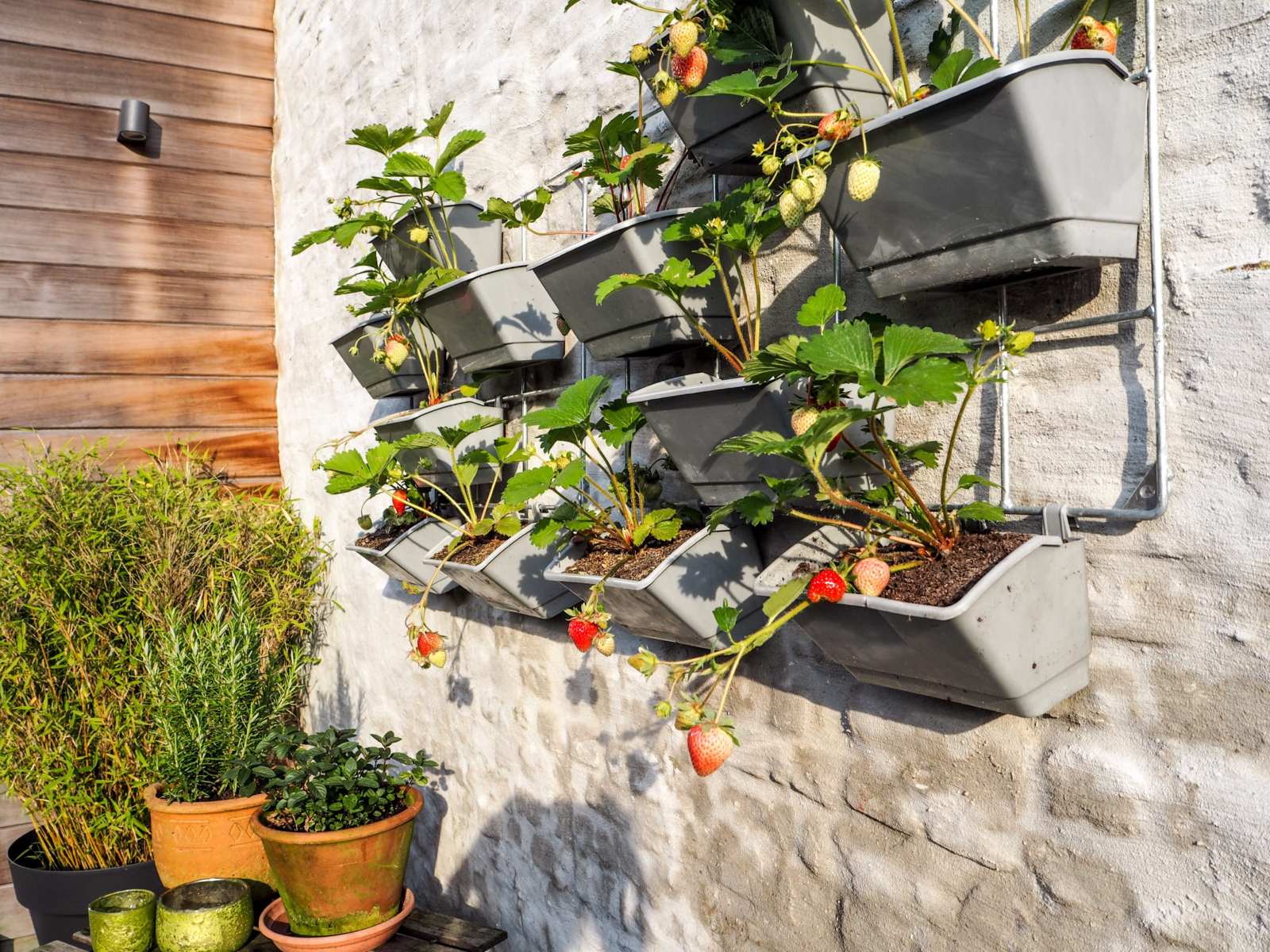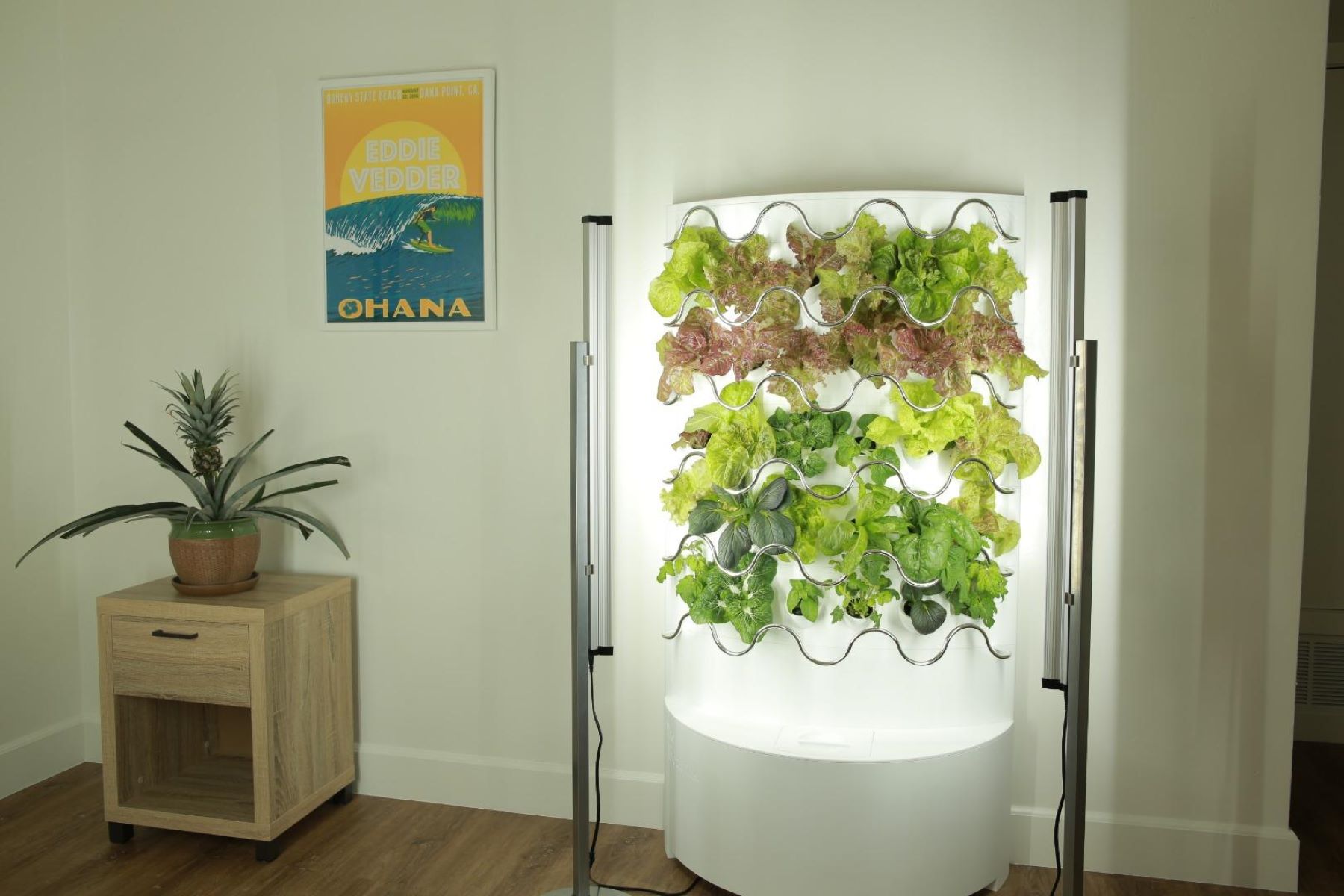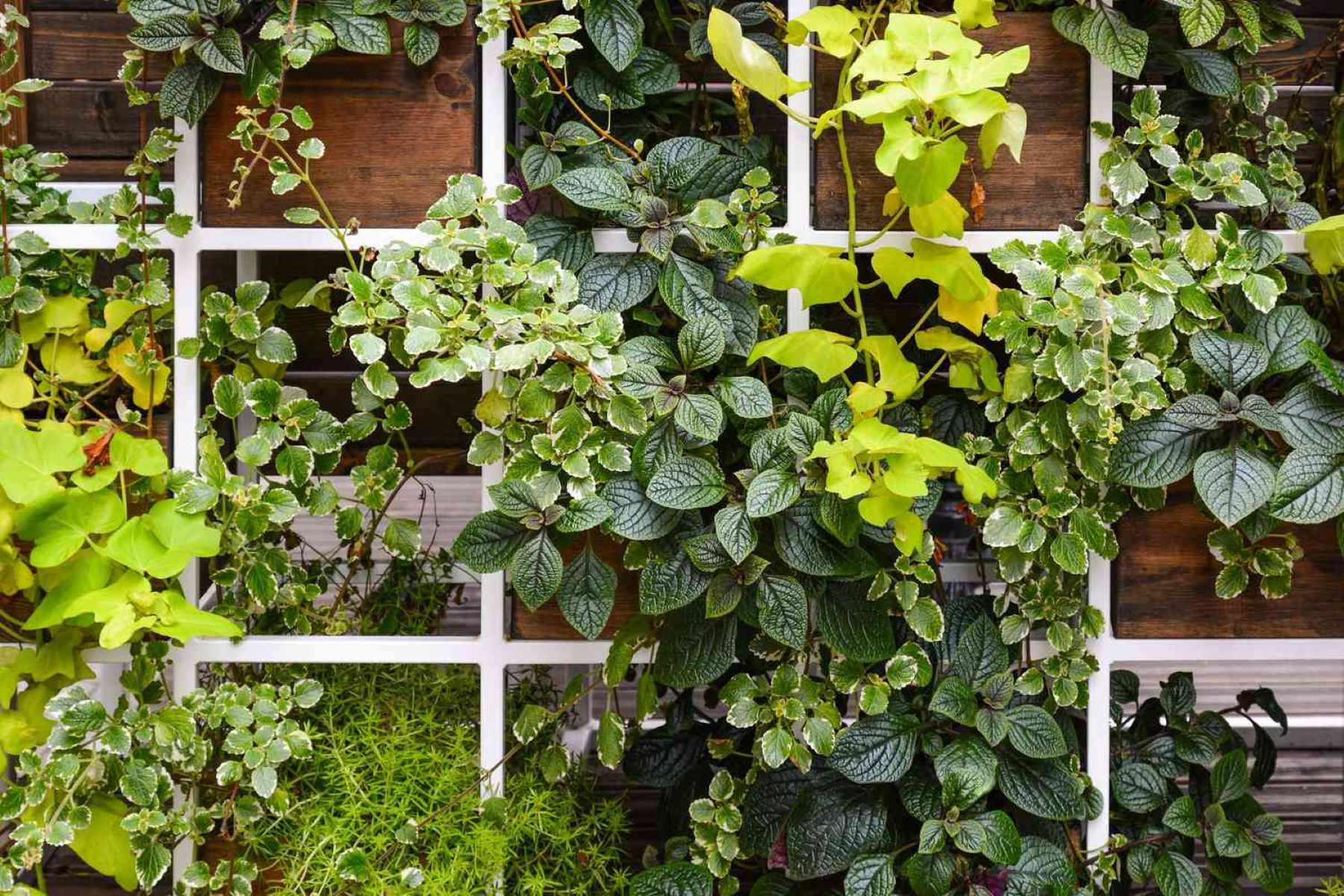Home>Garden Essentials>How To Plant Strawberry In A Vertical Garden


Garden Essentials
How To Plant Strawberry In A Vertical Garden
Modified: March 15, 2024
Learn how to create a stunning vertical garden with strawberries. Get expert tips on planting and maintaining your garden for a thriving outdoor oasis.
(Many of the links in this article redirect to a specific reviewed product. Your purchase of these products through affiliate links helps to generate commission for Storables.com, at no extra cost. Learn more)
Introduction
Welcome to the wonderful world of vertical gardening! If you’re looking to grow strawberries but have limited space, vertical gardening is the perfect solution for you. By utilizing vertical space, you can create a beautiful and productive garden right in your own backyard, balcony, or even indoors. In this article, we will explore the benefits of vertical gardening, guide you through selecting the right strawberry varieties, help you choose the perfect location, provide tips for building or buying a vertical garden system, and offer guidance on preparing the soil, planting, and caring for your vertical strawberry garden. So, let’s dive in and discover how to create a thriving and fruitful strawberry vertical garden!
Key Takeaways:
- Grow strawberries in a vertical garden to save space, increase yield, and create a beautiful, pest-resistant oasis. Enjoy fresh, homegrown strawberries with easy maintenance and bountiful harvests.
- Choose the right strawberry varieties, location, and care practices for a thriving vertical garden. Troubleshoot common issues and savor the joy of harvesting and enjoying your own delicious strawberries.
Benefits of Vertical Gardening
Vertical gardening offers a multitude of benefits for both experienced gardeners and beginners alike. Here are some of the key advantages of growing strawberries in a vertical garden:
1. Optimizing Space:
One of the primary benefits of vertical gardening is its ability to maximize limited space. By growing your strawberries vertically, you can make the most of small gardens, balconies, patios, or even unused walls. This is especially beneficial for urban dwellers or those with limited outdoor areas.
2. Increased Yield:
Vertical gardening allows you to grow more plants in a smaller area, leading to increased yields. By utilizing vertical structures such as trellises, hanging baskets, or wall-mounted planters, you can grow multiple strawberry plants without taking up much ground space.
3. Improved Air Circulation:
Growing strawberries vertically helps improve airflow around the plants, which can reduce the risk of pests and diseases. Enhanced air circulation also promotes pollination, leading to better fruit production and healthier plants.
Read more: How To Store Strawberry Plants Over Winter
4. Easier Maintenance:
Vertical gardens make it easier to tend to your strawberry plants. With the plants raised off the ground, you can easily access them for watering, pruning, and harvesting. This reduces the strain on your back and knees and makes maintenance tasks more convenient.
5. Aesthetically Pleasing:
Vertical gardens are not only practical but also visually appealing. They can transform a plain wall or empty space into a stunning green oasis. The lush foliage and vibrant red strawberries cascading down the vertical structures create a beautiful and inviting sight.
6. Protection from Pests:
Placing your strawberries in a vertical garden can help protect them from ground-dwelling pests, such as slugs and snails. Elevated plants are less accessible to these common garden nuisances, reducing the risk of damage to your strawberry crop.
Overall, vertical gardening offers a range of benefits, from maximizing space and increasing yield to improving air circulation and simplifying maintenance. Now that you understand why vertical gardening is advantageous let’s explore how to select the right strawberry varieties for your vertical garden.
Selecting the Right Strawberry Varieties
When it comes to choosing the right strawberry varieties for your vertical garden, there are a few factors to consider. Here are some key points to keep in mind:
1. Everbearing vs. June-bearing Strawberries:
Everbearing strawberries produce fruit throughout the growing season, while June-bearing strawberries produce a larger crop during a specific window of time. With vertical gardening, you have the flexibility to choose either type, depending on your preference and climate. Everbearing strawberries are often a popular choice for vertical gardens as they continuously produce fruit.
2. Compact and Runnerless Varieties:
Look for strawberry varieties that have a more compact growth habit and are runnerless or have minimal runners. These types of strawberries are well-suited for vertical gardening, as they won’t take up too much space or produce excessive runners that can overwhelm the vertical structure.
3. Disease Resistance:
Consider selecting strawberry varieties that have a good level of disease resistance. This can help prevent common fungal diseases, such as powdery mildew or gray mold, which can be a challenge in vertical gardening due to reduced airflow. Check the variety descriptions or consult with local nurseries or gardening experts for recommendations.
4. Flavor and Size:
Don’t forget about taste and size! Choose strawberry varieties that suit your preference when it comes to flavor and fruit size. Some varieties are renowned for their sweetness, while others have a more tart taste. Consider the size of the berries as well, as larger strawberries may require more support on the vertical structure.
Read more: How To Build Vertical Garden
5. Climate Adaptability:
Ensure that the strawberry varieties you choose are suitable for your specific climate. Pay attention to the recommended hardiness zones provided by seed catalogs or nurseries. Selecting varieties that are well-adapted to your climate will increase the chances of success and a fruitful harvest in your vertical garden.
Once you have a shortlist of strawberry varieties that meet your criteria, it’s time to move on to the next step: choosing the perfect location for your vertical strawberry garden.
Choosing the Perfect Location for Your Vertical Strawberry Garden
Now that you have your strawberry varieties selected, it’s time to find the ideal location for your vertical garden. Here are some important factors to consider:
1. Sunlight:
Strawberries thrive in full sun, so choose a location that receives at least 6-8 hours of direct sunlight each day. This will ensure optimal growth and fruit production. Observe your outdoor space throughout the day to identify areas with the most sun exposure.
2. Accessibility:
Consider how accessible your vertical garden will be for watering, harvesting, and general maintenance. Choose a location that is easily reached without hindrance. You want to be able to tend to your strawberries comfortably and efficiently.
Read more: How To Grow A Vertical Garden
3. Structural Support:
Ensure that the chosen location has suitable support for your vertical garden system. If you’re building a DIY structure, make sure the ground is stable and capable of supporting the weight of the system and plants. If using a pre-fabricated system, follow the manufacturer’s recommendations for installation.
4. Wind Protection:
Take into account any potential wind exposure in your chosen location. Excessive wind can damage the strawberry plants and hinder their growth. If your selected site is particularly windy, consider using windbreaks or placing the vertical garden against a wall or sturdy fence.
5. Proximity to Water Source:
It’s convenient to choose a location that is close to a water source for easy irrigation. Vertical gardens may require more frequent watering due to their elevated positioning, so having a water source nearby will save you time and effort.
6. Aesthetics:
Consider the overall aesthetics of the chosen location. Vertical gardens can serve as decorative elements in your outdoor space, so select an area that complements the surrounding environment and adds visual appeal.
By carefully considering these factors, you can find the perfect location that ensures your vertical strawberry garden thrives. With the location secured, it’s time to move on to the next step: building or buying a vertical garden system.
Read more: How To Plant Strawberries In Hanging Baskets
Building or Buying a Vertical Garden System
Now that you have chosen the location for your vertical strawberry garden, the next step is to determine whether you want to build a DIY system or purchase a pre-made vertical garden kit. Here are some considerations for each option:
Building a DIY System:
If you enjoy getting creative and prefer a customized approach, building your own vertical garden system can be a rewarding project. Here are the basic steps to follow:
- Choose your materials: Decide on the type of structure you want to build, such as a trellis, ladder, or hanging pots. Select materials that are durable, weather-resistant, and suitable for supporting the weight of your strawberry plants.
- Design and assemble: Sketch out a design and assemble the components of your vertical garden system according to your plan. Make sure to create enough space between each level for the strawberry plants to grow and spread.
- Add support: Ensure that your vertical garden structure is securely anchored to the ground or wall. This will provide stability and prevent it from toppling over in strong winds.
- Prepare the planting area: Before attaching your strawberry plants, prepare the planting area by lining it with a weed barrier and filling it with nutrient-rich soil or a suitable growing medium.
- Attach the strawberry plants: Plant your strawberry seedlings or runners in the designated spaces, making sure they have adequate access to sunlight.
Buying a Pre-Made Vertical Garden Kit:
If you prefer a convenient option or lack the necessary tools and skills for DIY construction, purchasing a pre-made vertical garden kit is a great alternative. Here are some factors to consider when selecting a kit:
- Size and Capacity: Choose a kit that accommodates the number of strawberry plants you intend to grow and fits well within your available space.
- Quality and Durability: Look for kits made from sturdy materials that can withstand outdoor conditions and provide long-lasting support for your strawberries.
- Ease of Assembly: Consider the assembly process and whether it comes with clear instructions and all the necessary components for easy installation.
- Drainage and Irrigation: Ensure that the kit has adequate drainage to prevent waterlogged roots and a built-in irrigation system or the option to easily add one.
- Reviews and Recommendations: Read customer reviews and seek recommendations to gauge the performance and satisfaction of other gardeners who have used the specific vertical garden kit you are considering.
Whether you choose to build your own system or purchase a pre-made kit, the most important aspect is to create a sturdy and stable structure that can support your strawberry plants. Once your vertical garden system is ready, it’s time to prepare the soil and start planting your strawberries.
Preparing the Soil and Planting the Strawberries
Before planting your strawberries in the vertical garden, it’s essential to properly prepare the soil to provide optimal growing conditions. Here’s a step-by-step guide to help you get started:
1. Clear the Area:
Remove any weeds, rocks, or debris from the planting area. This will create a clean space for your strawberry plants and reduce competition for nutrients and water.
2. Amend the Soil:
Strawberries prefer well-draining soil that is rich in organic matter. If your soil is heavy or clayey, amend it by adding compost, well-rotted manure, or peat moss to improve drainage and fertility. Mix these amendments into the soil evenly to ensure a well-balanced growing medium.
3. Adjust pH Levels:
Strawberries prefer slightly acidic soil with a pH level between 5.5 and 6.5. Test the soil pH using a soil testing kit, and if necessary, adjust it by adding lime to raise pH or sulfur to lower pH. Follow the manufacturer’s instructions for the appropriate dosage based on your soil test results.
4. Install the Growing Medium:
For vertical gardening, it’s best to use lightweight and well-draining growing mediums such as a combination of peat moss, perlite, and vermiculite. Fill the planting area of each level of your vertical garden system with the growing medium, leaving a small gap between the medium and the top edge of the container.
Read more: How To Plant Strawberries From Seed
5. Plant the Strawberries:
Now it’s time to plant your strawberry seedlings or runners in the prepared soil. Dig a small hole in the growing medium, ensuring it is large enough to accommodate the roots of the strawberry plant. Gently place the plant in the hole and cover the roots with soil, pressing it lightly to secure the plant in place.
6. Spacing and Positioning:
Proper spacing is crucial to allow each strawberry plant to grow and spread freely. Follow the recommended spacing guidelines provided with your strawberry variety, usually around 12 to 18 inches apart. Position the plants in a way that they are evenly distributed across each level of your vertical garden system.
7. Provide Support:
As your strawberry plants grow, they may require support to prevent them from hanging or falling over. Use stakes, trellises, or netting to guide the plants and provide vertical support. This will help prevent the fruit from touching the ground, reducing the risk of rot and pest damage.
Once your strawberry plants are in place and properly supported, it’s time to provide the necessary care to ensure their healthy growth. In the next section, we’ll discuss how to care for your vertical strawberry garden.
Caring for Your Vertical Strawberry Garden
Caring for your vertical strawberry garden is essential to ensure healthy growth, abundant fruit production, and overall plant vigor. Here are some crucial care practices to follow:
Read more: How To Grow Strawberry Plants From Seeds
1. Watering:
Strawberries require consistent moisture, especially during the growing and fruiting seasons. Water your vertical garden regularly, keeping the soil consistently moist but not waterlogged. Be mindful of the elevated position of your plants, as they may dry out more quickly than ground-level gardens. Adjust the frequency of watering based on weather conditions and the moisture needs of your specific strawberry variety.
2. Fertilizing:
Provide your strawberry plants with regular feeding to promote healthy growth and maximize fruit production. Apply a balanced fertilizer specifically formulated for strawberries following the label instructions. Start fertilizing a few weeks after planting and continue throughout the growing season at regular intervals as directed on the fertilizer packaging.
3. Pruning:
Regular pruning helps maintain plant health and encourages better airflow, reducing the risk of diseases. Remove any yellowing or diseased leaves, as well as runners that may divert energy from fruit production. Trim back excessive growth to maintain a manageable size and shape for your vertical garden. Prune after the fruiting season or as needed throughout the growing season.
4. Pollination:
To ensure proper pollination and fruit set, gently shake the vertical garden structure or use a small brush to transfer pollen between the flowers. Vertical gardens may have limited exposure to pollinators, so assisting in pollination can enhance fruit production. Repeat this process every few days during the flowering period to ensure adequate pollination.
Read more: How To Store Strawberry Roots
5. Pest and Disease Control:
Monitor your strawberry plants regularly for signs of pests, such as aphids, snails, slugs, or spider mites. Remove any pests you find by hand or use organic pest control methods if necessary. Keep an eye out for common strawberry diseases like powdery mildew or gray mold, and promptly take action to prevent their spread. Maintaining good airflow and providing proper spacing between plants can help reduce the risk of fungal diseases.
6. Support and Training:
As the strawberry plants grow, guide the vines along the vertical structure, ensuring they are well-supported and contained within their designated area. Regularly check for any loose or drooping branches that may need to be tied up or redirected to maintain an organized and visually appealing vertical garden.
By following these care practices, you can maintain a healthy vertical strawberry garden and enjoy a bountiful harvest of delicious strawberries. In the next section, we’ll discuss the exciting part: harvesting and enjoying your homegrown strawberries!
Harvesting and Enjoying Fresh Strawberries
Harvesting ripe and juicy strawberries from your vertical garden is an exciting and rewarding experience. Here are some guidelines to ensure that you harvest and enjoy your homegrown strawberries at their peak:
1. Monitor Ripeness:
Keep a close eye on your strawberry plants as the fruits begin to develop. Strawberries are ready to harvest when they turn fully red and have a glossy appearance. Avoid picking them when they are still partially green, as they may not fully develop their sweetness.
Read more: What Herbs To Grow In A Vertical Garden
2. Harvesting Technique:
Hold the strawberry gently near the stem and twist it with a slight upward motion, detaching it from the plant. Alternatively, you can use a pair of sharp scissors or pruning shears to cut the stem just above the strawberry. Take care not to damage the nearby fruits or any emerging flower buds.
3. Harvesting Frequency:
Check your vertical garden regularly and harvest strawberries as they ripen. The fruiting period can vary depending on the strawberry variety, but most will produce several waves of ripe fruits throughout the growing season. Harvesting frequently encourages the plant to produce more berries.
4. Enjoying Fresh Strawberries:
Freshly harvested strawberries are a delight to savor on their own, but they can also be used in a variety of culinary creations. Rinse the strawberries gently under cool water just before consuming or using them in recipes to remove any dirt or debris from the garden. Enjoy them as a healthy snack, add them to salads, create delectable desserts, or blend them into refreshing smoothies.
5. Storing Strawberries:
Strawberries have the best flavor and texture when consumed soon after harvesting. If you have a surplus of strawberries, store them in the refrigerator, unwashed, and loosely wrapped in a breathable container or paper towel to absorb excess moisture. Avoid storing them for too long, as strawberries are perishable and tend to lose their freshness over time.
Harvesting and enjoying your own homegrown strawberries from your vertical garden is a truly satisfying experience. The burst of flavor and freshness will make all your gardening efforts worthwhile. In the next section, we’ll discuss how to troubleshoot common issues that may arise in vertical strawberry gardens.
Troubleshooting Common Issues in Vertical Strawberry Gardens
While vertical gardening can be a great way to grow strawberries, it’s not without its challenges. Here are some common issues that may arise in vertical strawberry gardens and how to troubleshoot them:
1. Lack of Sunlight:
If your vertical garden is not receiving enough sunlight, your strawberry plants may struggle to grow and produce fruit. Monitor the sunlight exposure in your chosen location and consider relocating your vertical garden to a sunnier spot if necessary.
2. Overwatering or Underwatering:
Proper watering is essential for the health of your strawberry plants. Overwatering can lead to root rot and other diseases, while underwatering can cause the plants to wither and produce smaller fruits. Ensure that you maintain consistent moisture in the soil, neither allowing it to become waterlogged nor drying out completely.
3. Pest Infestation:
Strawberries can be susceptible to pests such as aphids, snails, slugs, or spider mites. Monitor your plants regularly for signs of pest infestation, and take prompt action if you notice any. Use organic pest control methods, such as handpicking, introducing beneficial insects, or using natural sprays, to keep pests under control.
Read more: How To Make Living Wall Vertical Garden
4. Disease Outbreaks:
Fungal diseases like powdery mildew and gray mold can affect strawberry plants, especially in environments with reduced airflow, such as vertical gardens. Proper ventilation and spacing between plants can help prevent the spread of diseases. If you notice signs of disease, remove any infected plant parts and consider applying organic fungicides as a preventative measure.
5. Nutrient Deficiencies:
If your strawberry plants are showing signs of yellowing leaves, stunted growth, or poor fruit production, it could indicate nutrient deficiencies. Regularly fertilize your plants with a balanced fertilizer specifically formulated for strawberries to ensure they receive the necessary nutrients for healthy growth and robust fruiting.
6. Runners Taking Over:
Strawberry plants tend to produce runners, which are long stems that can propagate new plants. While runners can be beneficial for expansion, they can also overcrowd and overwhelm your vertical garden. To prevent excessive spreading, regularly prune the runners and redirect them or remove them altogether if they are encroaching on other plants.
By being proactive and addressing these common issues in your vertical strawberry garden, you can help ensure the success and productivity of your plants. Now that you’re equipped with troubleshooting knowledge, it’s time to put it into practice and enjoy your thriving vertical strawberry garden!
With this comprehensive guide, you’re well on your way to creating a flourishing vertical strawberry garden. From selecting the right varieties to caring for your plants and troubleshooting issues, you have all the tools you need to enjoy a bountiful harvest of fresh and delicious strawberries right at home. Happy gardening!
Conclusion
Congratulations on embarking on the journey of creating your own vertical strawberry garden! With the knowledge and tips provided in this article, you now have the tools to maximize your space and enjoy a bountiful harvest of juicy, homegrown strawberries.
Vertical gardening offers numerous benefits, including space optimization, increased yield, improved air circulation, and easy maintenance. By carefully selecting the right strawberry varieties and choosing a suitable location, you can create a thriving and visually appealing vertical garden.
Whether you decide to build a DIY vertical garden system or opt for a pre-made kit, ensure that your structure provides the necessary support and stability for your strawberry plants. Preparing the soil properly and planting the strawberries with adequate spacing will contribute to their overall health and productivity.
Caring for your vertical strawberry garden involves regular watering, fertilizing, pruning, and keeping a watchful eye for pests and diseases. Remember to harvest your strawberries when they reach full ripeness, and savor the delicious taste of your homegrown fruit.
In troubleshooting common issues, such as sunlight, watering, pests, diseases, nutrient deficiencies, and runner management, you can overcome challenges and ensure the success of your vertical garden.
With dedication, patience, and a little bit of gardening know-how, your vertical strawberry garden will flourish and provide you with a source of joy, beauty, and delicious strawberries. So, roll up your sleeves, get your hands dirty, and enjoy the rewards of your efforts!
Remember, gardening is a continuous learning experience. Don’t be afraid to experiment, observe, and adjust your practices to suit the unique needs of your vertical garden and strawberry plants. Happy gardening and may your vertical strawberry garden bring you an abundance of flavorful, homegrown strawberries for years to come!
Frequently Asked Questions about How To Plant Strawberry In A Vertical Garden
Was this page helpful?
At Storables.com, we guarantee accurate and reliable information. Our content, validated by Expert Board Contributors, is crafted following stringent Editorial Policies. We're committed to providing you with well-researched, expert-backed insights for all your informational needs.




0 thoughts on “How To Plant Strawberry In A Vertical Garden”